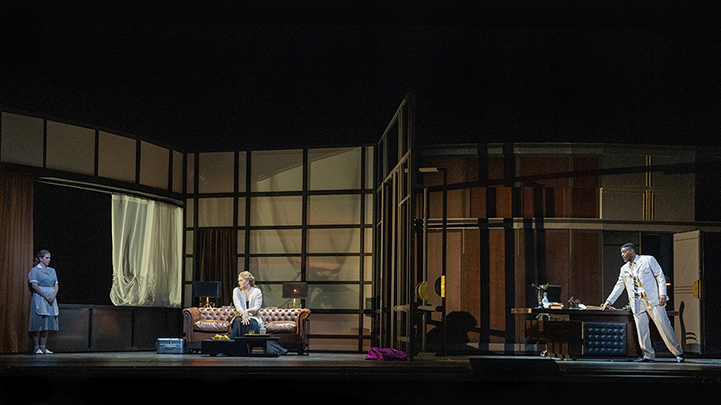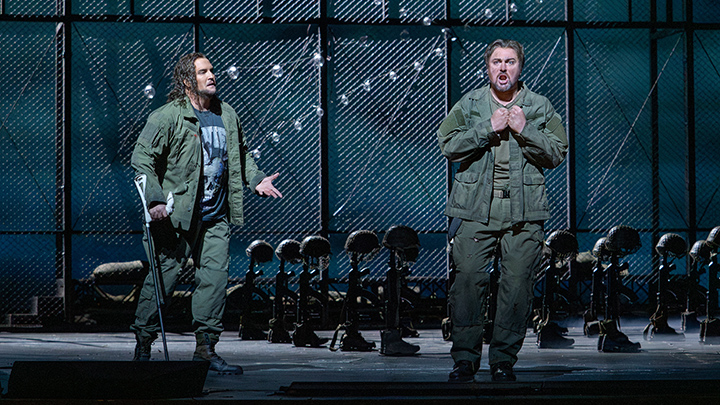
After withdrawing from Un ballo in maschera earlier in the season due to pregnancy, Elena Stikhina sang her first local Verdi lead, replacing Lise Davidsen as the tragically fated Leonora di Vargas. No one would envy a single following in the footsteps of such an ecstatically acclaimed performance, but Stikhina acquitted herself honorably, while also not being a totally ideal complement to the role.
Stikhina’s positive elements were evident from the beginning: although not particularly large, her voice easily filled the hall, even in the role’s quieter moments, and she spun delicately crafted lines with phenomenal breath control. Her ability to ethereally float piano notes was her glory, suggesting that Desdemona might be a natural future assignment. Her acting choices tended toward projecting Leonora’s wounded nature—as each torturous degradation from God piled upon her, she seemed especially pathetic in her plight—which made her tenderly pitiable “Madre, pietosa vergine” a performance highlight.
Still, these ears wanted a touch more oomph to the sound and a little more willingness to use chest voice—especially in “Pace, pace mio dio,” which underlined everything she did well and everything that was lacking. Yannick Nézet-Séguin, who up to then had been an unfailingly generous accompanist, couldn’t resist turning up the volume in the aria’s more fervent passages, which resulted in Stikhina’s being swamped. The overall limpid quality of Stikhina’s voice felt ill-suited to the opera’s passionate conclusion. Still, no one could doubt that she is a gifted and intelligent artist, and one who will benefit the Met’s roster for years to come.
The only other deviation from the opening night cast came in the form of Maria Barakova replacing Judit Kutasi as Preziosilla. I enjoyed Barakova as Sonyetka in the Boston Symphony Orchestra concert of Lady Macbeth of Mtsensk at Carnegie Hall this year, but found her rather lightweight mezzo a size too small for this outlandish role. She also touched the part’s higher notes but tended to get off of them as quickly as possible. Barakova looked like a million bucks in the peculiar costumes supplied by Mortiz Junge—somewhere between Sally Bowles and Charlotte Rampling in The Night Porter—but it was hard to make sense of the production’s conception of the character, which turns the camp follower into mere camp.
Tenor Brian Jagde wielded his large voice like a blunt instrument in the first act, but by the extended showcases for Don Alvaro in Acts 3 and 4, he acquired a substantial beauty of tone that compensated for any other deficits. One wished perhaps for a bit more variation in his volume, but there was no question that this was the kind of heroic tenor sound too long absent at the Met. In “Invano Alvaro,” he paired wonderfully with the luscious, true-Verdi baritone of Igor Golovatenko, who was outstanding throughout in his first Italian assignment in the house.
Veteran house singer Patrick Carfizzi provided the most consistently beautiful singing of the performance, and the conception of Fra Melitone as a malevolent enforcer rather than a bumbling comic stock figure was the one truly successful element of Mariusz Treli?ski’s production concept. Particularly next to Soloman Howard, who struggled with pitch and legato in his dual assignments as Padre Guardiano and the Marquis of Calatrava, it was a pleasure to hear a low voice in such fine working order.
Nézet-Séguin’s reading of the score smartly balanced the pulsing drama of Verdi’s music with an essential lyricism, and it showed off the particularly high current standard of the Met’s orchestral musicians. In the first act, the low strings projected the rush of adrenaline surrounding Leonora’s proposed escape with Alvaro, as well as her extraordinary longing. The clarinet solo that accompanies Alvaro’s third-act aria was achingly beautiful, and the harps that underpin “Pace, pace” had a wiry energy to them—an angelic instrument stripped of its peace.
Much ink has already been spilled about Treli?ski’s eye-catching but empty production. The ever-spinning turntable probably looked cool as captured by HD cameras, but inside the house, it made for little more than a distracting steeplechase. The video-game interludes that explained the directorial concept for the production merely zapped the story’s momentum. The Met has clearly put a lot of paper into this staging, its first in thirty years, and will surely want to capitalize on that investment with future revivals. Whether it will seem more cogent or coherent down the road is a matter, like so much else in this opera, left up to fate.
Photos: Karen Almond/MetOpera



























Comments